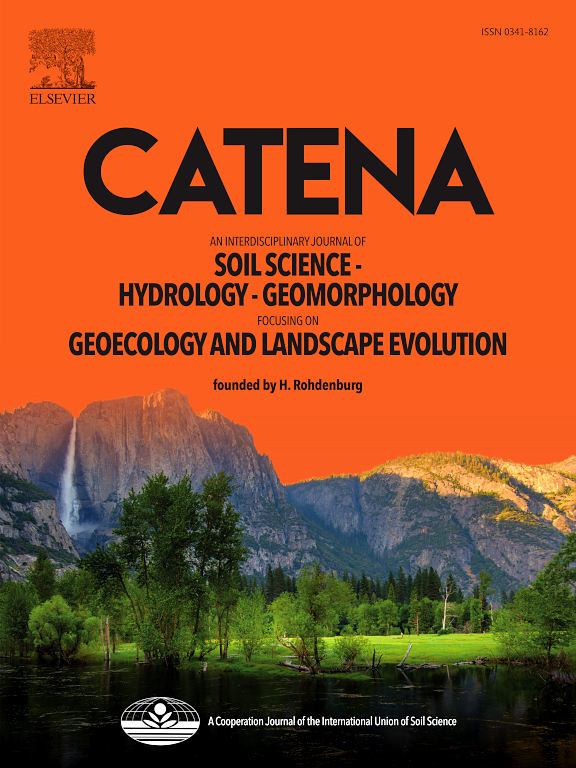Application of mass balance and unmixing model to trace sediment sources in an agricultural catchment
IF 5.4
1区 农林科学
Q1 GEOSCIENCES, MULTIDISCIPLINARY
引用次数: 0
Abstract
Sediment deposition gives rise to a variety of environmental issues, which pose a significant threat to ecological safety. Information regarding the sources of topsoil and sediment sinks in the catchment is crucial for understanding the soil erosion process and can aid in the development of targeted catchment management strategies. Fingerprinting models, such as the mass balance and unmixing models, are important quantitative tools for identifying erosion sources and sinks. This study aims to quantify sediment sources in an agricultural catchment and compare the effectiveness of the genetic algorithm-based mass balance model with the Monte Carlo-based unmixing model within the composite fingerprint technique for tracing sediment. Topsoil samples representing four land use types (i.e., slope farmlands, terrace fields, river banks, and road banks) and four geological units (i.e., J2s, J3sn, J3p, and Qh) were selected as potential sediment sources, while sediment samples collected over three years from Changshou Lake were used as sink samples. The mass balance model results indicated that the average contributions from slope farmlands, terrace fields, river banks, and road banks were 70.8 %, 3.0 %, 22.1 %, and 4.1 %, respectively. Contributions from J2s, J3sn, J3p, and Qh were 22.3 %, 66.6 %, 5.2 %, and 5.9 %, respectively. In contrast, the unmixing model results indicated that road banks and J3sn were the primary contributors to sediment sources in the agricultural catchment. This can be attributed to factors such as steep topography, frequent agricultural activities, and road construction, which made slope farmlands and road banks the primary sources of sediment. Due to their intrinsic physical properties, J3sn and J2s weather more rapidly, have shorter migration paths, and are frequently subject to agricultural production activities, making them major contributors to sediment. Both models allow for the quantification of sediment sources through geochemical fingerprints. However, the genetic algorithm-based mass balance model was chosen for this study due to its higher goodness-of-fit (GOF) and lower uncertainties. The average GOFs of the mass balance model were 91.5 % for land use and 94.2 % for geological units. The findings of this study provide a scientific foundation for sediment source modeling and comprehensive catchment erosion management, as well as a more accurate guide for the application of the mass balance and unmixing models in sediment source studies.

泥沙沉积会引发各种环境问题,对生态安全构成重大威胁。有关集水区表土来源和沉积物汇的信息对于了解土壤侵蚀过程至关重要,有助于制定有针对性的集水区管理策略。质量平衡和非混合模型等指纹识别模型是确定侵蚀源和汇的重要定量工具。本研究旨在量化农业集水区的沉积物来源,并比较基于遗传算法的质量平衡模型和基于蒙特卡洛的非混合模型在复合指纹技术中追踪沉积物的有效性。研究选取了代表四种土地利用类型(即坡耕地、梯田、河岸和路岸)和四种地质单元(即 J2s、J3sn、J3p 和 Qh)的表土样本作为潜在的沉积物源样本,同时将长寿湖三年来采集的沉积物样本作为沉积物汇样本。质量平衡模型结果表明,坡耕地、梯田、河岸和路岸的平均贡献率分别为 70.8%、3.0%、22.1% 和 4.1%。J2s、J3sn、J3p 和 Qh 的贡献率分别为 22.3%、66.6%、5.2% 和 5.9%。相比之下,非混合模型结果表明,路堤和 J3sn 是农业集水区泥沙来源的主要来源。这可归因于陡峭的地形、频繁的农业活动和道路建设等因素,这些因素使得坡耕地和路基成为泥沙的主要来源。由于其固有的物理特性,J3sn 和 J2s 的风化速度更快、迁移路径更短、农业生产活动频繁,因此成为泥沙的主要来源。这两种模型都可以通过地球化学指纹来量化沉积物来源。不过,由于基于遗传算法的质量平衡模型拟合度(GOF)较高,不确定性较低,因此本研究选择了该模型。在土地利用和地质单元方面,质量平衡模型的平均拟合优度分别为 91.5%和 94.2%。本研究的结果为泥沙来源建模和流域侵蚀综合治理提供了科学依据,也为质量平衡模型和非混合模型在泥沙来源研究中的应用提供了更准确的指导。
本文章由计算机程序翻译,如有差异,请以英文原文为准。
求助全文
约1分钟内获得全文
求助全文
来源期刊

Catena
环境科学-地球科学综合
CiteScore
10.50
自引率
9.70%
发文量
816
审稿时长
54 days
期刊介绍:
Catena publishes papers describing original field and laboratory investigations and reviews on geoecology and landscape evolution with emphasis on interdisciplinary aspects of soil science, hydrology and geomorphology. It aims to disseminate new knowledge and foster better understanding of the physical environment, of evolutionary sequences that have resulted in past and current landscapes, and of the natural processes that are likely to determine the fate of our terrestrial environment.
Papers within any one of the above topics are welcome provided they are of sufficiently wide interest and relevance.
 求助内容:
求助内容: 应助结果提醒方式:
应助结果提醒方式:


